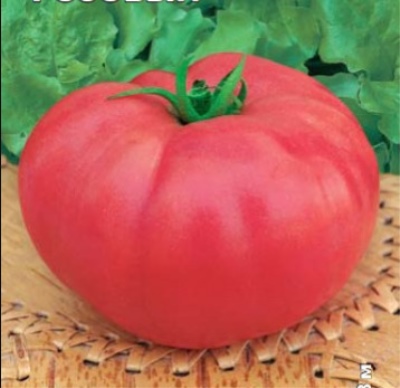
- Category: grade
- Growth type: indeterminate
- Appointment: fresh consumption
- Ripening period: early
- Ripening time, days: 93-100
- Growing conditions: for open ground, for film greenhouses
- Bush size: tall
- Bush height, cm: 150-180
- Ripe fruit color: pink
- Fruit shape: flat-round
Impressive size and great taste - the Chinese pink tomato fully justifies its popularity among gardeners due to its excellent characteristics. Despite its exotic origin, the variety successfully takes root in the Russian climate. And also among its advantages include good keeping quality and transportability, easy ripening after being removed from the branches.
Description of the variety
The tomato is indeterminate, with the beginning of flowering it does not stop its growth. Shoots up to 180 cm high in the greenhouse and up to 150 cm in the open field are formed straight, strong. The bush is not too densely leafy.
The main qualities of the fruit
The peel of ripe tomatoes is pink, unripe fruits are light green. The tomato has a flat-round shape, very large in size, the weight of each varies within 500-700 g. The pulp is also pink, slightly colored, but fleshy, saturated with juice.
Taste characteristics
The fruit has a pronounced sweetness. The taste is pleasant, salad.
Ripening and fruiting
Chinese pink is an early tomato. You can start harvesting fruits 93-100 days after the emergence of shoots.
Yield
The variety is considered to be high yielding.
The timing of planting seedlings and planting in the ground
Tomatoes are sown early, from late February or early March. The seedlings will be ready for transfer to the ground in early June. Tomatoes can be planted under the film from the 2nd decade of May.

Growing tomato seedlings is an extremely important process, because it largely depends on whether the gardener will be able to harvest at all. All aspects must be taken into account, from seedbed preparation to planting in the ground.
Landing scheme
For a tall variety, placement of up to 3 plants per 1 m2 will be the norm.

Growing and care
The Chinese pink tomato can be planted in greenhouses, under film, as well as outdoors. Formation is carried out in 1 or 2 stems. Tall center shoots require a garter or they can break under the weight of the fruit. The stepchildren break off throughout the growing season, from the moment the first flower cluster appears. The variety is sensitive to the amount of sunlight; for planting it is worth choosing places that are well lit, especially if it is planned to ripen the crop in the beds.
The soil substrate for transplantation is prepared in advance by digging up the soil with humus in the fall. So the earth will acquire a more fertile composition, saturated with nitrogen and other useful substances. The Chinese pink tomato also responds well to fertilizers. It is imperative to make top dressing during flowering and the formation of ovaries on the bushes.A good solution during this period would be a mixture of superphosphate with mullein, diluted with water in a ratio of 1: 10.
And also among the useful fertilizers for tomatoes of this variety, one can distinguish a liquid solution of potassium sulfate, combined with a nitroammophos. Top dressing is stopped if foliage growth becomes too active, and ovaries are not formed. For more abundant fruiting, a set of fruits, it is recommended to completely break off all shoots above 6 branches. This is the method of formation used in China.
Watering tomatoes, especially in a greenhouse, must be carefully regulated. Until the formation of ovaries, a water consumption of no more than 3 liters per week will be sufficient. In extreme heat, this figure is slightly increased. In cold and humid periods - cut, not forgetting about airing the greenhouse. With the appearance on the branches of tomatoes, the rates and frequency of watering are increased.




A plant needs different micronutrients at each stage of growth. All fertilizers can be divided into two groups: mineral and organic. Folk remedies are often used: iodine, yeast, bird droppings, eggshells.
It is important to observe the rate and period of feeding. This also applies to folk remedies and organic fertilizers.
Disease and pest resistance
Chinese pink tomato is highly resistant to most nightshade diseases. Not susceptible to the development of fusarium. Chemical treatment with fungicides is carried out exclusively during periods of increased risk of the spread of fungal diseases. To a greater extent, it is necessary in greenhouse conditions. When selecting funds, it is worth considering the stage of plant vegetation - during the filling of fruits, only safe compounds should be used that do not accumulate in the tissues of tomatoes.


Resistant to adverse weather conditions
The variety tolerates significant temperature changes well. It successfully withstands frosts if they are short-term.
Growing regions
The Chinese pink tomato has successfully passed the test of different climatic zones. It is grown under the film from the Central regions to the Chernozem region. In the subtropical climate of the Krasnodar Territory, open field cultivation is possible.
Review overview
According to gardeners, the Chinese pink tomato has proven itself as a salad variety, but giant tomatoes are also great for processing into juice, ketchup and sauces. The light shade of the peel creates some difficulties in determining ripeness. But experienced summer residents can cope with this without any problems, if necessary, simply bringing the tomatoes to ripeness at home. Vegetable growers notice that in open field bushes, record-sized fruits are rare, but in greenhouse conditions, you can count on weights of up to 0.5 kg for each of the removed tomatoes.

























































































